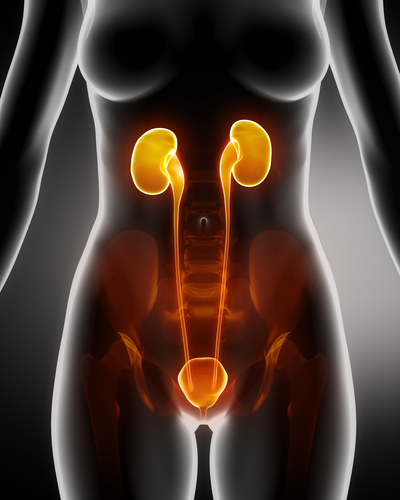
Anterior view of female bladder
Botox is a term which has now received every day use and familiarity because of its huge applications in the cosmetic industry. Botox is used, as we all know, for reducing the appearance of wrinkles in both men and women. It also has quite a few therapeutic applications, such as in the treatment of cervical dystonia, blepharospasm, chronic migraines, etc. A new potential application has emerged that could very well popularize the use of Botox even more.
In May 2015, The American Urological Association was presented the results of multicenter surveys conducted by three different teams, on the use of Botulinum toxin (Onabotulinum toxin A) for the treatment of Overactive Bladder Syndrome as well as neurogenic bladder dysfunction. Overactive bladder syndrome is a condition where patients feel the need to urinate multiples times in the day and the night, s much so that it interferes with daily routine. In addition, most patients also have urinary incontinence, which means that they frequently lose bladder control and end up leaking urine, in small amounts. As you can expect, this has a huge negative impact on their quality of life. And both these conditions are worsened by lifestyle diseases such as diabetes, having a sedentary routine and lack of exercise, obesity, drinking coffee or any sources of caffeine, etc. So while a number of factors are implicated in worsening it, there is no exact cause, which makes treatment difficult.
However, the study conducted proves otherwise. In a three year study which was initially randomized, researchers found that the patients who were injected with Botox had almost completely restored bladder control. The mechanism of action of Botox, even in the face, is that it acts on nerves and stops them from transmitting signals. This action, in the bladder, translates to directly reducing the ‘feeling’ or ‘urge’ to urinate even on a partially filled bladder. As a result, patients do not need to ‘go’ as often, and can control their bladder vastly better. It was also noticed that patients with fewer treatments had much better response than patients who received more treatments, which only goes to show the lasting efficacy of Botox for the bladder. In fact, some patients were able to maintain control for up to a year after just one treatment. This mode of treatment of bladder control issues with Botox could very well revolutionize the treatment approach for people with urinary incontinence.
It was also noted that patients showed brilliant responses to long term therapy, with a noticeable reduction in the number of times they had to urinate during the day and night, as well as better control over the ‘urge’. The lack of side effects was another significant factor. However some patients did develop mild urinary tract infections, possible as a consequence of intstrumentation, but urinary tract infections are already an extremely common occurrence in people with urinary incontinence, so the link may be to the preexisting disease rather than the treatment. There were no other side effects noted at all.
A second study was conducted to analyze the effect of Botox in patients who have Overactive Bladder syndrome which doesn’t have a specific cause (idiopathic), to determine if acute urinary retention occurs in patients who have been given Botox and required catherization, and if so, if it occurs because of the treatment. It was found that a large percentage of patients who developed acute urinary retention were diabetics. But in the course of the whole study, only a small percentage developed acute urinary retention, and the researchers settled with listing acute urinary retention as a possible risk, as well as needing to alter the definition of urinary retention to better be understood, as well.
A third study was conducted in patients who have neurogenic bladder problems. Neurogenic Detrusor Overactivity is a condition seen in patients who have had spinal injuries or nerve injuries, or are suffering from nerve degenerative disorders like multiple sclerosis. As a consequence of the overactivity, the detrusor muscle contracts while urinating, interrupting the voiding of the bladder. This leads to urge incontinence, residual urine volume in the bladder, nighttime wetting and leaking of the bladder during the day, etc. While the conservative mode of treatment is teaching these patients to catheterize themselves to void their bladder completely, Botox injections have come to the forefront as an excellent treatment option.
The aforementioned study was conducted over a period of four years, measuring the response in patients as well as the change in the consistency of the response in patients, over the four year period of time. It was found that not only did almost all the patients have a reduction in bladder overactivity by more than 50%, but the response was sustained. Their bladder control did not diminish over the period of time, either, but rather, improved. This makes Botox eminently suited in becoming the first line of treatment for suitable patients, rather than having to make the patients catherize themselves just to void their bladder.
Further applications of Botox (onabotulinum A toxin) are also being researched.
Are you a medical professional interested in learning how Botox can be used to enhance your business? See our live interactive, online course at dentox.com/all-courses/botox-training/







